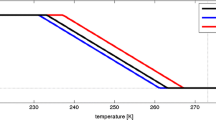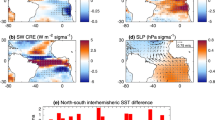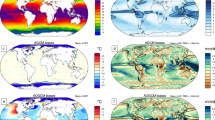Abstract
In HadGEM2-A, AMIP experiments forced with observed sea surface temperatures respond to uniform and patterned +4 K SST perturbations with strong positive cloud feedbacks in the subtropical stratocumulus/trade cumulus transition regions. Over the subtropical Northeast Pacific at 137°W/26°N, the boundary layer cloud fraction reduces considerably in the AMIP +4 K patterned SST experiment. The near-surface wind speed and the air-sea temperature difference reduces, while the near-surface relative humidity increases. These changes limit the local increase in surface evaporation to just 3 W/m2 or 0.6 %/K. Previous studies have suggested that increases in surface evaporation may be required to maintain maritime boundary layer cloud in a warmer climate. This suggests that the supply of water vapour from surface evaporation may not be increasing enough to maintain the low level cloud fraction in the warmer climate in HadGEM2-A. Sensitivity tests which force the surface evaporation to increase substantially in the +4 K patterned SST experiment result in smaller changes in boundary layer cloud and a weaker cloud feedback in HadGEM2-A, supporting this idea. Although global mean surface evaporation in climate models increases robustly with global temperature (and the resulting increase in atmospheric radiative cooling), local values may increase much less, having a significant impact on cloud feedback. These results suggest a coupling between cloud feedback and the hydrological cycle via changes in the patterns of surface evaporation. A better understanding of both the factors controlling local changes in surface evaporation and the sensitivity of clouds to such changes may be required to understand the reasons for inter-model differences in subtropical cloud feedback.






Similar content being viewed by others
Notes
see CLIVAR Exchanges, May 2011 http://www.clivar.org/publications/exchanges.
References
Allen MR, Ingram WJ (2002) Constraints on future changes in climate and the hydrologic cycle. Nature 419:224–232
Andrews T, Forster PM (2008) CO2 forcing induces semi-direct effects with consequences for climate feedback interpretations. Geophys Res Lett 35:L04,802. doi:10.1029/2007GL032273
Andrews T, Gregory JM, Webb MJ, Taylor KE (2012a) Forcing, feedbacks and climate sensitivity in CMIP5 coupled atmosphere-ocean climate models. Geophys Res Lett 39(7):L09,712. doi:10.1029/2012GL051607
Andrews T, Ringer MA, Doutriaux-Boucher M, Webb MJ, Collins W (2012b) Sensitivity of an earth system climate model to idealised radiative forcing. Geophys Res Lett 39(6). doi:10.1029/2012GL051942
Blossey PN, Bretherton CS, Wyant MC (2009) Understanding subtropical low cloud response to a warmer climate in a superparameterized climate model. Part II: Column modeling with a cloud-resolving model. J Adv Model Earth Syst 1. doi:10.3894/JAMES.2009.1.8
Blossey PN, Bretherton CS, Zhang M, Cheng A, Endo S, Heus T, Liu Y, Lock AP, de Roode SR, Xu KM (2012) Marine low cloud sensitivity to an idealized climate change: The CGILS LES intercomparison. J Adv Model Earth Syst (submitted)
Bodas-Salcedo A, Webb MJ, Bony S, Chepfer H, Dufresne JL, Klein S, Zhang Y, Marchand R, Haynes JM, Pincus R, John VO (2011) COSP: satellite simulation software for model assessment. Bull Am Meteorol Soc 92(8):1023–1043. doi:10.1175/2011BAMS2856.1
Bony S, Dufresne JL (2005) Marine boundary layer clouds at the heart of cloud feedback uncertainties in climate models. Geophys Res Lett 32(20):L20,806
Bony S, Colman R, Kattsov VM, Allan RP, Bretherton CS, Dufresne JL, Hall A, Hallegate S, Holland MM, Ingram WJ, Randall DA, Soden BJ, Tselioudis G, Webb MJ (2006) How well do we understand and evaluate climate change feedback processes? J Clim 19(15):3445–3482. doi:10.1175/JCLI3819.1
Bretherton CS, Wyant MC (1997) Moisture transport, lower-tropospheric stability, and decoupling of cloud-topped boundary layers. J Atmos Sci 51(1):148–167
Bretherton CS, Blossey PN, Jones CR (2012) Mechanisms of marine low cloud sensitivity to idealized climate perturbations: A single-LES exploration extending the CGILS cases. J Adv Model Earth Syst (submitted)
Brient F, Bony S (2012) Interpretation of the positive low-cloud feedback predicted by a climate model under global warming. Clim Dyn. doi:10.1007/s00382-011-1279-7
Caldwell P, Bretherton CS (2009) Response of a subtropical stratocumulus-capped mixed layer to climate and aerosol changes. J Clim 22:20–38
Cess RD, Potter GL, Blanchet JP, Boer GJ, Del Genio AD, Déqué M, Dymnikov V, Galin V, Gates WL, Ghan SJ, Kiehl JT, Lacis AA, Le Treut H, Li ZX, Liang XZ, McAvaney BJ, Meleshko VP, Mitchell JFB, Morcrette JJ, Randall DA, Rikus L, Roeckner E, Royer JF, Schlese U, Sheinin DA, Slingo A, Sokolov AP, Taylor KE, Washington WM, Wetherald RT, Yagai I, Zhang MH (1990) Intercomparison and interpretation of climate feedback processes in 19 atmospheric general circulation models. J Geophys Res 95:16601–16615
Charney JG (1979) Carbon dioxide and climate: A scientific assessment. National Academy of Sciences
Chepfer H, Bony S, Winker D, Chiriaco M, Dufresne JL, Sèze G (2008) Use of CALIPSO lidar observations to evaluate the cloudiness simulated by a climate model. Geophys Res Lett 35:L15704. doi:10.1029/2008GL034207
Chepfer H, Bony S, Winker D, Cesana G, Dufresne JL, Minnis P, Stubenrauch CJ, Zeng S (2010) The GCM oriented Calipso cloud Product (CALIPSO-GOCCP). J Geophys Res 115:D00H16. doi:10.1029/2009JD012251
Clement AC, Burgman R, Norris JR (2009) Observational and model evidence for positive low-level cloud feedback. Science 325(5939):460–464. doi:10.1126/science.1171255
Colman R (2003) A comparison of climate feedbacks in general circulation models. Clim Dyn 20:865–873
Deardorff JW (1980) Cloud-top entrainment instability. J Atmos Sci 131–147
Dong B, Gregory JM, Sutton R (2009) Understanding land-sea warming contrast in response to increasing greenhouse gases. Part I: transient adjustment. J Clim 22:3079–3097. doi:10.1175/2009JCLI2652.1
Dufresne JL, Bony S (2008) An assessment of the primary sources of spread of global warming estimates from coupled atmosphere–ocean models. J Clim 21:5135–5144. doi:10.1175/2008JCLI2239.1
Gregory JM, Webb MJ (2008) Tropospheric adjustment induces a cloud component in CO2 forcing. J Clim 21:58–71
Johns TC, Durman CF, Banks HT, Roberts MJ, McLaren AJ, Ridley JK, Senior CA, Williams KD, Jones A, Rickard GJ, Cusack S, Ingram WJ, Crucifix M, Sexton DMH, Joshi MM, Dong BW, Spencer H, Hill RSR, Gregory JM, Keen AB, Pardaens AK, Lowe JA, Bodas-Salcedo A, Stark S, Searl Y (2006) The new Hadley Centre climate model HadGEM1: evaluation of coupled simulations. J Clim 19(7):1327–1353
Klein SA, Hartmann DL (1993) The seasonal cycle of low stratiform clouds. J Clim 6(8):1587–1606
Klein SA, Hartmann DL, Norris JR (1995) On the relationships among low-cloud structure, sea-surface temperature and atmospheric circulation in the summertime northeast Pacific. J Clim 8(5):1140–1155
Lock AP (2009) Factors influencing cloud area at the capping inversion for shallow cumulus clouds. Q J R Meteorol Soc 135:941–952
Mapes BE, Bacmeister J, Khairoutdinov M, Hannay C, Zhao M (2009) Virtual eld campaigns on deep tropical convection in climate models. J Clim 22(2):244–257. doi:10.1175/2008JCLI2203.1
Martin GM, Bellouin N, Collins WJ, Culverwell ID, Halloran PR, Hardiman SC, Hinton TJ, Jones CD, et al (2011) The HadGEM2 family of Met Office Unified model climate configurations. Geosci Model Dev 4:723–757. doi:10.5194/gmd-4-723-2011
Medeiros B, Stevens B, Held IM, Zhao M, Williamson DL, Olson JG, Bretherton CS (2008) Aquaplanets, climate sensitivity, and low clouds. J Clim 21(19):4974–4991. doi:10.1175/2008JCLI1995.1
Miller RL (1997) Tropical thermostats and low cloud cover. J Clim 10:409–440
Mitchell JFB, Wilson CA, Cunnington WM (1987) On co2 climate sensitivity and model dependence of results. Q J R Meteorol Soc 113:293–322
Moeng CH (2000) Entrainment rate, cloud fraction, and liquid water path of PBL stratocumulus clouds. J Atmos Sci 3627–3643
Ogura T, Emori S, Webb MJ, Tsushima Y, Yokohata T, Abe-Ouchi A, Kimoto M (2008) Towards understanding cloud response in atmospheric GCMs: the use of tendency diagnostics. J Meteorol Soc Jpn 86(1):69–79
Randall DA (1980) Conditional instability of the first kind upside-down. J Atmos Sci 37:125–130
Randall DA, Wood RA, Bony S, Colman R, Fichefet T, Fyfe J, Kattsov V, Pitman A, Shukla J, Srinivasan J, Stouffer RJ, Sumi A, Taylor KE (2007) Climate models and their evaluation. In: Solomon S, Qin D, Manning M, Chen Z, Marquis MC, Averyt KB, Tignor M, Miller HL (eds) Climate Change 2007: the physical science basis. Contribution of Working Group I to the fourth assessment report of the intergovernmental panel on climate change, pp 589–662
Richter I, Xie SP (2008) Muted precipitation increase in global warming simulations: a surface evaporation perspective. J Geophys Res 113. doi:10.1029/2008JD010561
Rieck M, Nuijens L, Stevens B (2012) Marine boundary-layer cloud feedbacks in a constant relative humidity atmosphere. J Atmos Sci. doi:10.1175/JAS-D-11-0203.1
Smith RNB (1990) A scheme for predicting layer clouds and their water content in a general circulation model. Q J R Meteorol Soc 116:435–460
Soden BJ, Held IM (2006) An assessment of climate feedbacks in coupled ocean–atmosphere models. J Clim 19:3354–3360
Soden BJ, Vecchi GA (2011) The vertical distribution of cloud feedback in coupled ocean–atmosphere models. Geophys Res Lett 38:12704. doi:10.1029/2011GL047632
Soden BJ, Broccoli AJ, Hemler RS (2004) On the use of cloud forcing to estimate cloud feedback. J Clim 17(19):3661–3665. doi:10.1175/1520-0442(2004)017
Stevens B, Brenguier JL (2009) Cloud controlling factors—low clouds. In: Clouds in the perturbed climate system
Taylor KE, Crucifix M, Braconnot P, Hewitt CD, Doutriaux C, Broccoli AJ, Mitchell JFB, Webb MJ (2007) Estimating shortwave radiative forcing and response in climate models. J Clim 20:2530–2543
Taylor KE, Stouffer RJ, Meehl GA (2012) An overview of CMIP5 and the experiment design. Bull Am Meteorol Soc 93:485–498. doi:10.1175/BAMS-D-11-00094.1
Teixeira J, Cardoso S, Bonazzola M, Cole J, Del Genio A, Demott C, Franklin C, Hannay C, Jakob C, Jiao Y, Karlsson J, Kitagawa H, Kohler M, Kuwano-Yoshida A, Ledrian C, Lock A, Miller MJ, Marquet P, Martins J, Mechoso CR, Meijgaard EV, Meinke I, Miranda PMA, Mironov D, Neggers R, Pan HL, Randall DA, Rasch PJ, Rockel B, Rossow WB, Ritter B, Siebesma AP, Soares P, Turk FJ, Vaillancourt PA, Von Engeln A, Zhao M (2011) Tropical and sub-tropical cloud transitions in weather and climate prediction models: the GCSS/WGNE Pacific Crosssection Intercomparison (GPCI). J Clim 24:5223–5256
Trenberth KE, Fasullo JT (2010) Simulation of present-day and twenty-first-century energy budgets of the southern oceans. J Clim 23(2):440–454. doi:10.1175/2009JCLI3152.1
Tsushima Y, Emori S, Ogura T, Kimoto M, Webb MJ, Williams KD, Ringer MA, Soden BJ, Li B, Andonova N (2006) Importance of the mixed-phase cloud distribution in the control climate for assessing the response of clouds to carbon dioxide increase: a multi-model study. Clim Dyn. doi:10.1007/s00382-006-0127-7
Vecchi GA, Soden BJ (2007) Global warming and the weakening of the tropical circulation. J Clim 20(17):4316–4340. doi:10.1175/JCLI4258.1
Webb MJ, Senior CA, Sexton DMH, Ingram WJ, Williams KD, Ringer MA, McAvaney BJ, Colman R, Soden BJ, Gudgel R, Knutson T, Emori S, Ogura T, Tsushima Y, Andronova NG, Li B, Musat I, Bony S, Taylor KE (2006) On the contribution of local feedback mechanisms to the range of climate sensitivity in two GCM ensembles. Clim Dyn 27(1):17–38. doi:10.1007/s00382-006-0111-2
Webb MJ, Lambert FH, Gregory JM (2012) Origins of differences in climate sensitivity, forcing and feedback in climate models. Clim Dyn. doi:10.1007/s00382-012-1336-x
Wetherald RT, Manabe S (1988) Cloud feedback processes in a general circulation model. J Atmos Sci 45:1397–1415
Williams KD, Tselioudis G (2007) GCM intercomparison of global cloud regimes: present-day evaluation and climate change response. Clim Dyn 29:231–250. doi:10.1007/s00382-007-0232-2
Williamson DL, Boyle J, Cederwall R, Fiorino M, Hnilo J, Olson J, Phillips T, Potter G, Xie SC (2005) Moisture and temperature balances at the atmospheric radiation measurement southern great plains site in forecasts with the community atmosphere model (CAM2). J Geophys Res 110(D15S16):17
Wood R, Bretherton CS (2006) On the relationship between stratiform low cloud cover and lower tropospheric stability. J Clim 19:6425–6432
Wyant MC, Bretherton CS, Bacmeister JT, Kiehl JT, Held IM, Zhao M, Klein SA, Soden BJ (2006) A comparison of low-latitude cloud properties and their response to climate change in three agcms sorted into regimes using mid-tropospheric vertical velocity. Clim Dyn 27(2–3):261–279. doi:10.1007/s00382-006-0138-4
Wyant MC, Bretherton CS, Blossey PN (2009) Understanding subtropical low cloud response to a warmer climate in a superparameterized climate model. part i: Regime sorting and physical mechanisms. J Adv Model Earth Syst 1. doi:10.3894/JAMES.2009.1.7
Zhang M, Bretherton CS (2008) Mechanisms of low cloud climate feedback in idealized single-column simulations with the community atmospheric model (cam3). J Clim 21(18):4859–4878. doi:10.1175/2008JCLI2237.1
Zhang M, Bretherton CS, Blossey PN, Austin PA, Bacmeister JT, Bony S, Brient F, Cheng A, Roode SRD, Endo S, Del Genio AD, Franklin CN, Golaz JC, Hannay C, Heus T, Isotta FA, Dufresne JL, Kang IS, Kawai H, Koehler M, Kumar S, Larson VE, Liu Y, Lock AP, Lohman U, Khairoutdinov MF, Molod AM, Neggers RAJ, Rasch P, Sandu I, Senkbeil R, Siebesma AP, Siegenthaler-Le Drian C, Stevens B, Suarez MJ, Xu KM, von Salzen K, Webb MJ, Wolf A, Zhao M (2012a) CGILS: First results from an international project to understand the physical mechanisms of low cloud feedbacks in general circulation models. Bull Am Meteorol Soc (submitted)
Zhang M, Bretherton CS, Blossey PN, Bony S, Brient F, Golaz JC (2012b) The CGILS experimental design to investigate low cloud feedbacks in general circulation models by using single-column and large-eddy simulation models. J Adv Model Earth Syst (submitted)
Acknowledgments
We would like to acknowledge Brian Soden for creating the CMIP5/CFMIP-2 patterned SST forcing dataset, and Yoko Tsushima and Tim Hinton for setting up and testing the tendency diagnostics in HadGEM2. We are also grateful to William Ingram, Roy Kershaw, Hugo Lambert, Bjorn Stevens, Peter Blossey and an anonymous reviewer for helpful comments on the manuscript, and to Sandrine Bony and Florent Brient for useful discussions. This work was supported by the Joint DECC/Defra Met Office Hadley Centre Climate Programme (GA01101). The research leading to these results has received funding from the European Union, Seventh Framework Programme (FP7/2007–2013) under grant agreement number 244067 via the EU CLoud Intercomparison and Process Study Evaluation project (EUCLIPSE).
Author information
Authors and Affiliations
Corresponding author
Rights and permissions
About this article
Cite this article
Webb, M.J., Lock, A.P. Coupling between subtropical cloud feedback and the local hydrological cycle in a climate model. Clim Dyn 41, 1923–1939 (2013). https://doi.org/10.1007/s00382-012-1608-5
Received:
Accepted:
Published:
Issue Date:
DOI: https://doi.org/10.1007/s00382-012-1608-5




